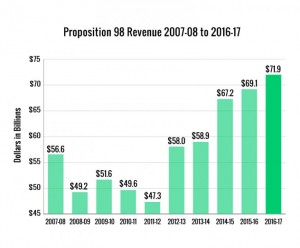 Developing environmental literacy in elementary, middle and high school is essential to prepare learners for an evolving economy and to equip them with the skills and experiences they need to tackle urgent environmental challenges, both globally and in their own communities. By 2030, it is estimated that 24 million green jobs will be created in industries ranging from energy to finance and transportation.1 Yet too few individuals enter the workforce with the necessary environmental competencies and dispositions.
Developing environmental literacy in elementary, middle and high school is essential to prepare learners for an evolving economy and to equip them with the skills and experiences they need to tackle urgent environmental challenges, both globally and in their own communities. By 2030, it is estimated that 24 million green jobs will be created in industries ranging from energy to finance and transportation.1 Yet too few individuals enter the workforce with the necessary environmental competencies and dispositions.
A survey of college students published in 2018 identified misconceptions about the environment and the role of humans in environmental problems and scored students an average of 52 percent out of 100 percent on environmental literacy.2 Considering the role that Career Technical Education (CTE) has in career preparation for the current and future world of work, and the desire for programs to be responsive to the needs of the economy and community, the value of environmental literacy has never been more important for CTE learners.
The state of Delaware, in particular, is no stranger to the impacts climate change will bring to the jobs landscape. Because of Delaware’s geography, environmental changes threaten economic activity, well-being, and preservation of the state’s wetlands and waterways; accordingly, there is an urgent need to develop and cultivate environmental literacy among youth, not only to instill awareness and responsibility for the environment but also to prepare young people for the workplace of the future. To begin deeper conversations about the intersection of CTE and environmental literacy, Advance CTE partnered with the Delaware Department of Education to explore what environmental literacy competencies could look like within and across Delaware Pathways.
Supported by a Bay Watershed Education and Training (B-WET) grant through the National Oceanic and Atmospheric Administration (NOAA), the two-year project involves developing a cross-cutting environmental literacy framework, validated by Delaware educators, environmental literacy experts, industry stakeholders and other leaders. Once validated, the framework will be published on the Delaware Pathways website. In the second year of the grant, the project team will begin professional development activities supported by NOAA and other partners to implement the framework in CTE programs statewide. This commitment to environmental literacy is further evidenced through and builds upon the Delaware Climate Action Plan, which specifically lists “Increase the availability of climate change educational programming” as a core activity for improving outreach and education impacts.
The objective for the project is to demonstrate how environmental literacy competencies can be integrated into middle and high school CTE programs in the state of Delaware, including career and academic advising, and to build the capacity of state and local leaders to ensure all students, in particular under-represented and historically marginalized learners, graduate environmentally literate. Delaware Director of Career and Technical Education and STEM Initiatives Dr. Jon Wickert echoes this sentiment: “The shifting geopolitical landscape has laid bare the fact that all jobs are green jobs, and economic, public, and community health is directly impacted by public policy, business decision-making, and the consumer choices available as a result. The next generation has no choice but to address the environmental challenges previous generations have bequeathed and it is our responsibility to equip them with sufficient environmental literacy to do so successfully. Their future depends on it.”
This project will hopefully serve as a pilot to bring more awareness and understanding about the environment to CTE learners, build problem-solving and critical thinking skills that link academic and technical knowledge, and equip a new generation of learners to successfully participate in a greener economy. As a final deliverable, Advance CTE will be developing a case study at the conclusion of this grant to model how states can develop an environmental literacy framework of their own or integrate the framework developed with Delaware in their own state’s CTE delivery system. Stay tuned for more information about this project!
Dan Hinderliter, Senior Policy Associate


 With students now on summer vacation, policymakers have been hard at work preparing for the upcoming school year – and Career Technical Education (CTE) has been front and center in several states. Last month, California approved a massive budget, including funds for the CTE Pathways Program and the new Strong Workforce Program. Meanwhile, some states are exploring strategies to address teacher shortages.
With students now on summer vacation, policymakers have been hard at work preparing for the upcoming school year – and Career Technical Education (CTE) has been front and center in several states. Last month, California approved a massive budget, including funds for the CTE Pathways Program and the new Strong Workforce Program. Meanwhile, some states are exploring strategies to address teacher shortages.